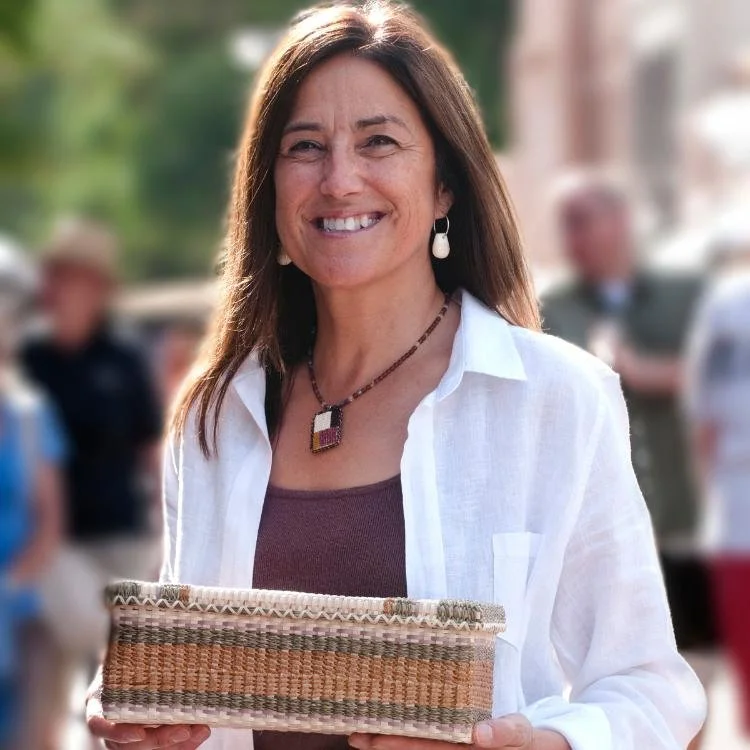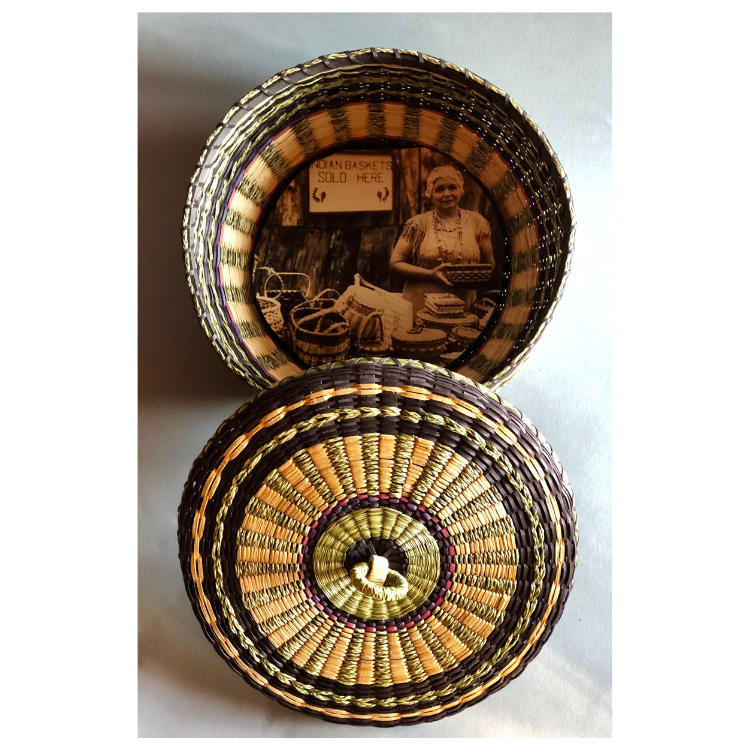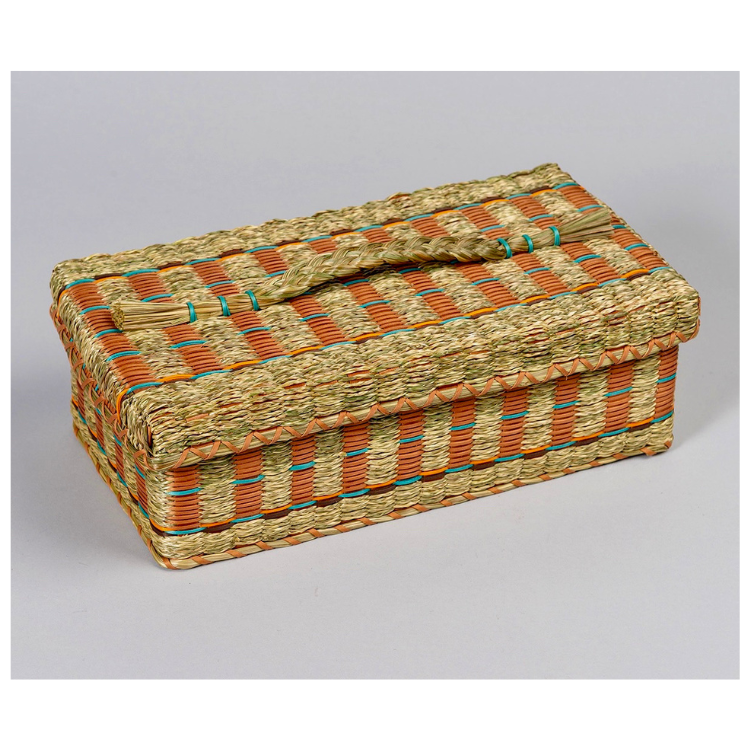Teresa Secord | Coastal Basket Weaving in Maine
Along Maine’s rugged coastline, where the Atlantic’s cold winds shape both land and lives, basket weaving is more than craft—it’s a living tradition woven through generations. From the rocky shores of Mount Desert Island to the quiet coves near Portland, artisans still harvest natural materials like sweetgrass, ash, and cedar to create baskets built to endure the coastal weather and daily work.
Theresa Secord (b. 1958) is a master Penobscot basket maker and the founding director of the Maine Indian Basketmakers Alliance (MIBA). She began learning the traditional craft in 1988 on Indian Island, Maine, under the guidance of the late Madeline Tomer Shay. Over her 21 years leading MIBA, Theresa has played a vital role in revitalizing the endangered art of ash and sweetgrass basketry. Thanks to her efforts, the average age of basket makers dropped from 63 to 40, and the number of active weavers across the Maliseet, Micmac, Passamaquoddy, and Penobscot tribes grew from 55 to over 100.
Theresa’s leadership and artistry have earned her numerous accolades, including the prestigious 2016 National Heritage Fellowship from the National Endowment for the Arts, the 2009 Jennifer Easton Community Spirit Award from the First Peoples Fund, and the 2003 Prize for Creativity in Rural Life, presented at the United Nations Women’s World Summit in Geneva, Switzerland, recognizing her work in helping basket makers rise out of poverty.
In recent years, Theresa was honored as a 2021 Luce Indigenous Knowledge Fellow and received an honorary doctorate from Colby College in 2022. She continues to weave traditional Wabanaki baskets using her great-grandmother’s wooden forms and tools, passed down through generations. As a dedicated teacher, Theresa has mentored many Native apprentices, ensuring the craft’s survival and growth.
Her exquisite baskets are held in museums and private collections nationwide, and she has won awards at numerous juried national art shows. Beyond her studio, Theresa remains a passionate advocate for Native artists, volunteering and consulting with museums across Maine and the country to support Indigenous art and culture.
For centuries, these coastal baskets have been tools of fishermen, farmers, and market vendors. Their sturdy frames carried everything from fresh clams and lobster traps to produce and keepsakes. Today, the craft carries an added layer of artistry—merging time-honored techniques with modern design sensibilities.
The Enduring Art of Maine Indian Basket Weavers
For thousands of years, the Native peoples of Maine—primarily the Penobscot, Passamaquoddy, Maliseet, and Micmac tribes—have woven baskets that are as vital as they are beautiful. These baskets aren’t just containers; they are living expressions of culture, utility, and connection to the land and water.
Crafted from local materials like sweetgrass, ash splints, birch bark, and cedar, each basket carries the story of the region’s forests and rivers. The weaving techniques have been passed down through generations, often taught by elders to children in a tradition that honors patience, skill, and respect for nature.
Historically, these baskets served a wide variety of daily needs—from gathering food to storing goods and even in ceremonial contexts. Their designs often reflect tribal symbolism and the natural patterns of the Maine landscape.
Today, Maine’s Native basket weavers continue to innovate while honoring these ancestral practices. Artists like Carrie Cornplanter (Seneca) and Clarissa Rizal (Tlingit, Alaska Native but influential nationally) have brought Native weaving into contemporary art spaces, and Maine’s own tribal weavers remain guardians of these traditions.
In recent years, there has been renewed interest in preserving and celebrating Native basketry, with tribal workshops, exhibitions, and collaborations that ensure this vibrant craft thrives for generations to come.
Roots in the Land and Sea
Basket weaving in Maine reflects a deep connection to the natural world. Harvesting materials is a ritual in itself: gathering pliable ash wood from forested groves, drying sweetgrass by the shore until fragrant, and preparing cedar bark with patient hands. This care for ingredients echoes the rhythms of the sea and seasons, a slow craft in a fast world.
Local artisans like Amy Dyer of Deer Isle keep the tradition alive, teaching workshops and creating functional yet beautiful baskets that honor Maine’s heritage. Amy’s work is a testament to the tactile magic of weaving—where every loop, twist, and fold forms a story.
A Basket for Every Purpose
From the iconic lobster pot gauge baskets to delicate market baskets, coastal basket weaving blends form and function. Many designs are shaped by necessity—large, open baskets for hauling shellfish; compact, tightly woven carriers for farmers’ markets. The enduring strength of the materials and techniques ensures these baskets last decades, weathering sun, salt, and storm.
Beyond their practical use, these baskets are now cherished as art—displayed on walls, used as statement pieces, or treasured heirlooms passed down through families.
Click Photo to Enlarge
More Than a Craft: A Community
Coastal basket weaving in Maine is woven into the fabric of its communities—gatherings, festivals, and markets where makers share stories, techniques, and inspiration. It’s a craft that celebrates patience, place, and connection. In a world rushing forward, these baskets remind us to slow down, appreciate natural beauty, and honor the hands that make with care.
Where to Stay and Eat Nearby
The Camden Harbour Inn — A cozy, waterfront retreat just minutes from basket workshops and galleries.
Long Grain — A charming spot in Camden serving fresh, local dishes inspired by Maine’s coast.







